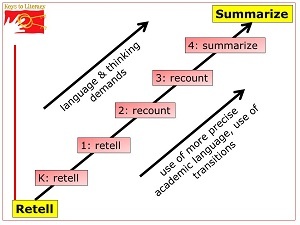Recount: Is it Relevant?

What is this “recount” thing in grades 2 and 3? What did the architects of the Common Core Standards mean when they put that in? Was it purposeful, or as some have suggested, simply an oversight? I have asked multiple audiences, made up of teachers, administrators and support staff who work with students in the primary grades what they think, their responses are always mixed. Some shake their heads, agreeing that of course the word choice was purposeful, while others are not as convinced. A search of the web nets similar results.
Whether you believe the Common Core Standards are “sloppy” or “intentional and nuanced”, I ask you to consider if this insertion makes sense. As an experienced educator, having worked with primary level students as a classroom teacher, special educator, and reading specialist, I believe that the movement from supplying a retell to producing a summary is much more of a leap than a step. When students must transition from “tell me everything you can remember about a story” to- “the main ideas, in order, with transition words” it involves an increased demand on, as well as a command and control of, both language and thinking skills. It also explains why teaches so often lament about their students’ lack of success with making this transition.
Why fill the gap with “recount”? The word itself can be defined as “to narrate or give a detailed account of” a story or event (AudioEnglish.org). It would seem based on this surface level understanding, that recount and retell are synonymous, perhaps this has contributed to the belief that there was an editing error in the CCSS. Further research of “recount” reveals however that it is a term commonly used in such places as the UK and Australia (among others) and refers to a particular form of writing and more sophisticated version of a retelling. The use of the word in this way seems to more closely align with the standards set forth in the Common Core. As students move across grade levels, the expectation shifts from a simple retelling of the key details (grade 1) to more sophisticated main idea work related to determining the central message, the focus of paragraphs, determining main ideas and providing explanations of how the key details support the main idea(s). The thinking demands of this progression shifts from the Remembering level of Bloom’s or a DOK 1 (Recall & Reproduction) to the Understanding level at a DOK 2 as they are asked to identify main ideas and explain relationships, and potentially a DOK 3 as they are asked to make inferences and provide text evidence (key details). Language demands also increase as students are expected to be more precise and concise with detail and word choices, use of transition or linking words, and using language to produce main idea and central message statements.
What should this look like in our second and third grade classrooms? We must provide our students with explicit instruction in comprehension, organization, language, and writing. We must recognize the progression, and use appropriate tools, scaffolds, and strategies along the way. There will be a need for modeling and thinking aloud, showing students how to do such things as determine and state main idea(s) and central message, locate key details, organize the information, create introductory statements, combine ideas, and use appropriate transition or linking words. Students will need time to practice in a hands on way, collaborating with their peers, and using oral rehearsal before being asked to write. In our Key Comprehension Primary Routine workshop we take a closer look at the progression and how we can support students in a variety of ways. I believe that most who initially thought the use of “recount” was unintentional, walk away understanding that the road to writing a summary is paved with more than a simple retell.
Also check out this informative post dated Jan. 29, 2013: Retell, Recount, Summarize? A Common Core Shift from Kindergarten to Grade 4.

Colleen, Thank you for such a cogent and succinct explanation of the process. As a Reading Specialist and Literacy Coach I find that students need that direct and explicit scaffolding of the retell to summarization process. Teachers knowledge of the steps and the leap is vital to their instruction.
Kirsten